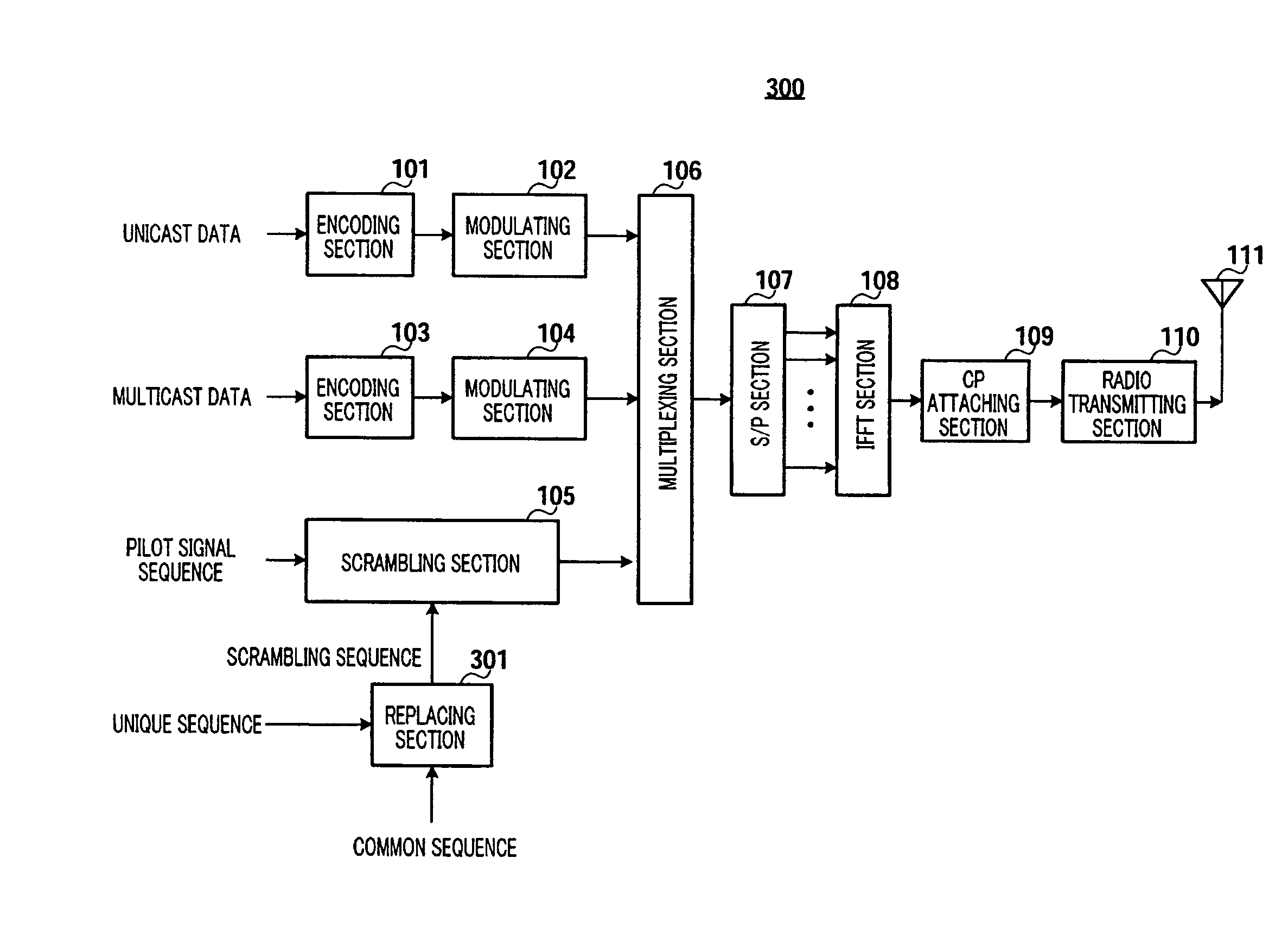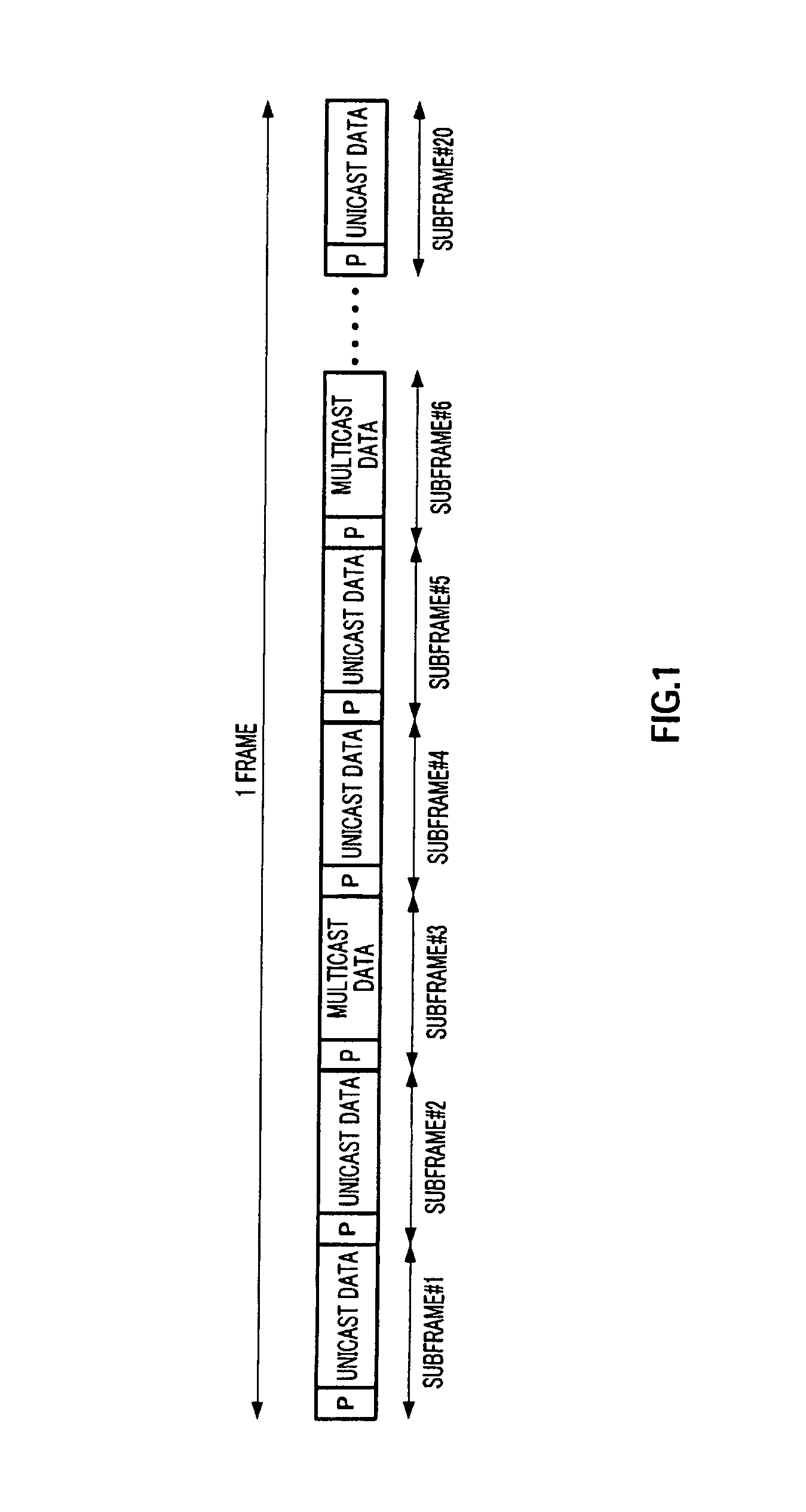Radio communication base station apparatus and pilot transmitting method
a radio communication and base station technology, applied in the direction of broadcasting with distribution, transmission path division, wireless commuication services, etc., can solve the problems of transmission performance degradation, delay wave due to multi-path cannot be avoided, etc., and achieve the effect of improving the accuracy of channel estimation value interpolation
- Summary
- Abstract
- Description
- Claims
- Application Information
AI Technical Summary
Benefits of technology
Problems solved by technology
Method used
Image
Examples
embodiment 1
[0040]The base station according to the present embodiment is used in a radio communication system. In this radio communication system, subframes which a plurality of base stations use to transmit mutually different data and subframes which a plurality of base stations use to transmit mutually same data, are time-multiplexed. In particular, the base station according to the present embodiment is adequate for a radio communication system where subframes for unicast data (hereinafter “unicast subframes”) and subframes for multicast data (hereinafter “multicast subframes”) are time-multiplexed, as shown in above-described FIG. 1. Therefore, in the following explanations, as an example, unicast subframes are used as the subframes which a plurality of base stations use to transmit mutually different data, and multicast subframes are used as the subframes which a plurality of base stations use to transmit the same data. Further, the frame structure according to the present embodiment is t...
embodiment 2
[0088]According to Embodiment 1, channel estimation value gi calculated when a channel estimation is performed for multicast data, is a channel estimation value comprised of channel estimation value hi for cell A and channel estimation value li for cell B, and, consequently, this calculated channel estimation value cannot be used for channel estimation for unicast data.
[0089]Therefore, with the present embodiment, out of the unique sequence and the common sequence included in the scrambling sequence, a phase rotation that is unique to a base station and that differs between cells is applied to the common sequence.
[0090]FIG. 16 illustrates the configuration of base station 500 according to the present embodiment. Base station 500 employs a configuration having phase rotating sections 501 and 502 in addition to the configuration shown in Embodiment 1 (FIG. 2). Here, in FIG. 16, the same components as in FIG. 2 will be assigned the same reference numerals and detail explanations thereo...
embodiment 3
[0099]A case will be explained below with the present embodiment where different multicast data is transmitted per cell group comprised of a plurality of cells. According to the present embodiment, for example, as shown in FIG. 18, in a case where cells A to G form cell group 1 and cells H to N form cell group 2, while multicast data 1 is transmitted in cells A to G of cell group 1, multicast data 2, which is different from multicast data 1, is transmitted in cells H to N of cell group 2.
[0100]In this case, if pilots for multicast subframes are mapped in the same positions in all cells, the accuracy of channel estimation for multicast data is assumed to degrade in cells nearby the cell group boundary (cells A, B, M and N in FIG. 18). For example, the accuracy of channel estimation for multicast data 1 is assumed to degrade in cells A and B in cell group 1, and, further, the accuracy of channel estimation for multicast data 2 is assumed to degrade in cells M and N in cell group 2. Th...
PUM
 Login to View More
Login to View More Abstract
Description
Claims
Application Information
 Login to View More
Login to View More - R&D
- Intellectual Property
- Life Sciences
- Materials
- Tech Scout
- Unparalleled Data Quality
- Higher Quality Content
- 60% Fewer Hallucinations
Browse by: Latest US Patents, China's latest patents, Technical Efficacy Thesaurus, Application Domain, Technology Topic, Popular Technical Reports.
© 2025 PatSnap. All rights reserved.Legal|Privacy policy|Modern Slavery Act Transparency Statement|Sitemap|About US| Contact US: help@patsnap.com



